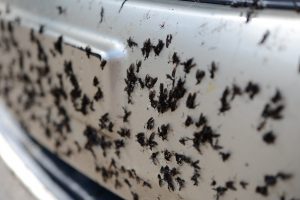The few things we can count on in Florida in the spring – heat, humidity, sunshine, and lovebugs. Yes, those small, black bugs that are everywhere, but especially splattered across the front of our cars. You are lucky if your daily commute keeps your speed under 45mph, because at highway speeds the front of every car is the color of lovebug splat.

About Lovebugs
Lovebugs, also called March flies, are in the order Diptera which includes flies, mosquitoes, and gnats. So, lovebugs are actually flies. Florida has two lovebug seasons: spring (April-May) and fall (August-September). Lovebugs are not native to Florida and to quash a long running myth – they were not created in a lab at the University of Florida to control the mosquito population. They originated from South America and discovered in Florida in 1949 in Escambia County. They are now found throughout the sunshine state.
Adult lovebugs are not poisonous, but they are distasteful to birds and other predators. Currently no biological controls have been identified for use against adult lovebugs, but numerous predators such as birds, spiders, earwigs, and centipedes find the lovebug larvae a delicious treat.
Although the lovebug is quite annoying, the good news is they do not bite or sting!
Lovebug Biology
Adult male lovebugs live for two to three days and adult females live up to seven days. They feed on nectar and are especially fond of sweet clover, goldenrod and Brazilian pepper.
Reproducing is the one goal in the lovebug’s short life. The term lovebug was coined from their mass mating rituals. They can be found in ratios as high as 10 males to 1 female while attempting to mate. After mating, females lay up to 600 eggs in open fields, pastures, and along roadways where pasture grass lines the shoulder and drainage ditches. Females lay their eggs directly on soil where the larvae feed on the organic matter and decaying vegetation. The larvae are living composters, breaking down debris and returning the nutrients to the soil.
The Lovebug Invasion
Adult lovebugs are attracted to car exhaust and lawnmowers. They are also attracted to heat, so they congregate in mass numbers at intersections. They usually fly between 1 to 5 feet off the ground and only during the warm periods of the day, usually between 10am and 6pm. At night they prefer to rest in shrubs or tall grass.
How to Ease the Pain of Lovebug Season
Ok, they are here for a few weeks, so here are a few tips to help get you through the season:
- Splat on, splat off – Wash the insects off your car as soon as possible. They are not acidic, but the fatty tissue from their squished bodies mixes with the sun and heat. This can cause pitting of the car finish, so try to be vigilant at washing them off your car at least every other day. Soak the car for a few minutes then lightly scrub off the dead bugs.
- Shine, shine away – Having a good wax coating on the car will help with bug removal. You can also spread a light coat of baby oil on the hood or use a front grill screen or deflector to try and minimize the number of insect strikes.
- We love the Florida sunshine and so do they – Lovebugs are active during the warm parts of the day, so it’s best to avoid driving between the hours of 10am and 4pm (if possible). They rest at night, so grocery shopping after dusk during lovebug season might be helpful.
- Resist the urge to squish – Think twice before using the smack technique to kill a lovebug inside your car or on your clothing. They can stain the upholstery as well as clothing, so the capture and release technique is recommended.
- Vacuum your way to a bug-free house – Vacuuming is good for removing the insects from your house and car.
- No Pesticides! – There are currently no products labeled for use against lovebugs. Attempting to combat them with chemicals will only lead to frustration, a misuse of chemicals, and no dead lovebugs.
I think we can all agree that lovebugs are incredibly annoying. On the bright side, their time here is short. We will soon be back to enjoying beautiful Florida, free of lovebugs, in just a few short weeks!
Resources
 0
0
